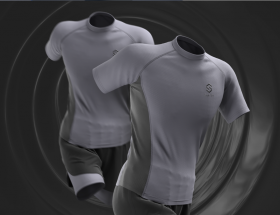Released in the first-ever DPC Report 2022, this executive interview with Eric Lui of Style3D is one of a twenty-part series that sees The Interline quiz executives from major DPC companies on the evolution of 3D and digital product creation tools and workflows, and ask their opinions on what the future holds for the the extended possibilities of digital assets.
For more on digital product creation in fashion, download the full DPC Report 2022 completely free of charge and ungated.
Digital product creation in fashion seems to have reached critical mass, with more brands than ever kick-starting or scaling DPC strategies. Why now?
I think the entire apparel supply chain is changing in response to consumer preferences and this requires digital R&D to adapt accordingly; the pandemic has also accelerated two industry challenges: skyrocketing labor costs and apparel companies’ shorter internal development cycles, and DPC helps to solve both; moreover, DPC workflows are more environmentally friendly than traditional processes by implementing digital transformations, apparel and textile companies can achieve more ambitious sustainable operations goals.
Perhaps the most powerful element of digital product creation is the ability for creative teams to bring their ideas to life quickly – experiment, iterating, and innovating without having to produce anything physically. The challenge is now making that same power available to everyone who influences the value chain, allowing them to tap into the same benefits, to interact and collaborate, without needing to actually be 3D designers themselves. What is your vision for the Style3D Cloud in helping to unlock the potential of DPC for a wider audience?
Our vision is to remove the main barriers to DPC. For example, creating your own fabric, trim and block libraries. This phase can slow down adoption at a time when the organization wants to move fast. We have an entire team dedicated to creating digital assets for our users; our Marketplace library is one of the largest apparel databases in the world. At last count, we had almost 50,000 assets including fabrics, trims, animations, avatars, artwork and more. Royalty free, downloadable and fully customizable by the user.

Another important point is to make digital tools more user- friendly. This empowers users to accelerate concept idealization and encourage experimentation. At the same time, provides the freedom to visualize and experiment with materials at an early stage, users can engage with materials in an immersive way and refine their decisions before committing to physical materials.
At the same time, working on increasing interoperability between different DPC tools so that users of all levels, with access to varying assets, can make use of DPC ecosystems and also contribute to enriching them.
In Style3D, we are also supporting DPC education and adoption for our next-gen fashion talents, so that they can understand and use our tools, and we can showcase curated DPC creations.
For companies that haven’t yet started working in 3D, or that may have piloted it in a particular area of their business, a significant question mark may be hanging over their ability to manage asset creation and use at the volume that’s going to be required. Do you believe the Style3D asset library – which contains fabrics, components, avatars, props and other assets – can answer that question?
Yes, Style3D’s asset library is designed for ever-changing internal and external-facing business needs.
Our library provides a rich source of pre-built fabric samples that can be searched, viewed, and exported. Users can edit and share their 3D files within one cloud-based place— anytime and anywhere.
Style3D users can also upload and import assets into their libraries. For example, uploading from local devices and importing f rom other applications (PLMs), third-party collaborators, and our Official Market. The cloud-based asset libraries are compatible with various formats (including OBJ, FBX, glTF, u3ma, GLB, SBSAR, DXF, etc.) and provide centralized, company-wide asset storage for 3D files (such as styles and fabrics).

Our digital asset management functions (DAM) are built in, to make business scaling easier. For example, a batch of assets can have descriptions fields customized to make search and retrieval simple. Platform users can also do online tasks, like reviewing and annotating a 3D file online.
Or importing a supplier’s 3D fabric asset to preview the draped fabric on a garment.
We also ensure an easy, safe, and secure asset sharing by using embedded functions like generating QR codes, adding watermarks, and exporting share links. Users can gain strategic business insights using the asset library platform.
There is a significant focus in this report on digital materials, and specifically on the need for material capture to take place at the source, followed by cataloguing, discovery and collaboration. What do you see as the near- term and longer-term figure of managing the material supply chain (both new materials and waste) effectively, digitally?
Based on our experience with numerous vendors, we can share some learning for global end-to-end supply chain digitization:
Style3D has been championing this from our first day as a company. Everything starts with the fabric which is why we invested so much in developing our own simulation engine and tools to make digitizing fabric easy, accurate and cost effective. Furthermore, our Fabric solution can create digital fabrics that can be used on all the major 3D creation tools today.
With our Style3D Cloud, brands and vendors can connect and share digital fabrics from anyplace in the world before a physical swatch has been mailed. Both parties can be confident that the fabric will drape and behave on the screen the same as it will in real life. The textures will come alive.

They can allocate digital materials to a line plan library, and provide customized access to each of their partners. Using our SDK, allows fashion professionals to view 3D models and create 3D designs straight in your application. Transform your creative workflows and perfect your ideas using the power of Cloud SDK. Time, materials, costs, and confusion are reduced in this DPC framework.
Increase the utility of digital assets. When assets are used in multiple ways, by stakeholders, compelling efficiencies can be achieved. We can continue our brand example, thinking of a digital shirt as the asset. The virtual style can be easily duplicated and edited to generate color combinations, and preview various dimensions. The assortment can be fit on avatars that showcase the brand’s full size range, and the styled shirts can be used to quickly generate assortment boards for wholesaler presentations that buyers can confidently choose form. Boards could also be presented within Style3D Cloud, so potential buyers can browse. The brand can analyze digital engagement to guide future designs and in-season production orders.
Shift most activities online to elevate the ecosystem. With Style3D Cloud tools, everyone within an organization can transition their workflow to DPC and ramp up their productivity—this seamless digital collaboration extends to partner teams too. As ecosystem use is widely adopted, more and more assets are available across the digital supply network. That helps everyone proceed effectively, without the many delays, expenses, and waste embedded in current offline processes.
Continually develop your materials digitization. There is no endpoint for materials digitization. Every single day, our scientific team is working hard to provide an even more exceptional level of fabric illustration and rendering. To achieve scaled up DPC, we need scaled up digital fabrics. To establish digital supply chains, we need reliably precise materials—especially for soft-tissue simulation.
The potential to create and sell digital fashion is something that a lot of businesses want to tap into, although a lot of uncertainty remains around the shape of the metaverse and the commercial opportunities it creates. This makes a strong argument for taking an approach to digital product creation that benefits digital-for-physical processes, as well as laying the foundations for digital-for-digital business models. Is this the approach you’re taking? And do you see fashion brands having genuinely viable digital business units in the near future?
There are a lot of uncertainties about the metaverse. Different companies and organizations are continuing to discover its true value and we don’t really have an answer yet, in terms of its actual shape.
Yes, at Style3D we’re taking an approach that benefits both kinds of processes because we see them as interrelated.

We are taking steps into the metaverse, leveraging our unique strengths and exceptional scientific talent to create stunning digital content for each of our clients. By providing our users with exceptional content services and assets, we’re empowering their own discoveries in the metaverse.
At the same time, by creating incredible digital twins—a fundamental element for the ‘metaverse industry’—the physical apparel industry is significantly optimized.
Within the current apparel industry, we’re witnessing the booming trend of digital content, and we look forward to seeing digital fashion, in all its forms, continue blooming in the near future.
Where do you see digital product creation – and digital assets – going from here? What does the near-future look like for the industry and for your business?
Overall, barriers to DPC entry will keep shrinking. Physical and digital products and experiences will be increasingly combined, and their adoption across product categories and end-consumers will widen. We’ve already seen large suppliers and brands striving to establish internal DPC teams.
Instead of digital 3D being isolated to special projects for dedicated specialists, DPC tools and processes will underpin product life cycles. Advances in computer processors, algorithms, cloud computing, and more will continue shattering the expectations for realistic and real- time 3D interaction and as visualization becomes nimbler and lifelike, more businesses and consumers will embrace emerging concept such as metaverse or web3 participation. How this business could grow, is still open ended.
From a technical industry standpoint, a necessary progression for digital assets will be the creation of shared industry standards for digital material properties. Mass industrial adoption is directly related to digital- to-physical reliability. Once materials assets have standardized attributes— across platforms and file formats— we’ll reach a new stage of digitization.
We are ready to accept the challenges and the unknowns of the future. We plan to help the industry lead, during this transition, by providing the best in class digital tools.

This article is cited from The Interline.







